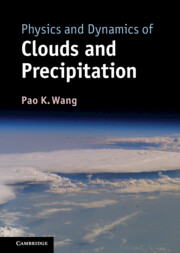Book contents
- Frontmatter
- Contents
- Preface
- 1 Observation of clouds
- 2 The shape and size of cloud and precipitation particles
- 3 Molecular structures of water substance
- 4 Bulk thermodynamic equilibrium among water vapor, liquid water, and ice
- 5 Surface thermodynamics of water substance
- 6 Aerosol in the atmosphere
- 7 Nucleation
- 8 Hydrodynamics of cloud and precipitation particles
- 9 Diffusion growth and evaporation of cloud and precipitation particles
- 10 Collision, coalescence, breakup, and melting
- 11 Cloud drop population dynamics in the warm rain process
- 12 Fundamental cloud dynamics
- 13 Numerical cloud models
- 14 Cloud electricity
- 15 Clouds–environment interaction
- References
- Index
- Plate section
10 - Collision, coalescence, breakup, and melting
Published online by Cambridge University Press: 05 March 2013
- Frontmatter
- Contents
- Preface
- 1 Observation of clouds
- 2 The shape and size of cloud and precipitation particles
- 3 Molecular structures of water substance
- 4 Bulk thermodynamic equilibrium among water vapor, liquid water, and ice
- 5 Surface thermodynamics of water substance
- 6 Aerosol in the atmosphere
- 7 Nucleation
- 8 Hydrodynamics of cloud and precipitation particles
- 9 Diffusion growth and evaporation of cloud and precipitation particles
- 10 Collision, coalescence, breakup, and melting
- 11 Cloud drop population dynamics in the warm rain process
- 12 Fundamental cloud dynamics
- 13 Numerical cloud models
- 14 Cloud electricity
- 15 Clouds–environment interaction
- References
- Index
- Plate section
Summary
The diffusion growth discussed in the last chapter undoubtedly dominates the growth of cloud particles in the initial stage of cloud formation. But the diffusion growth rate becomes very slow once a particle reaches a certain size (about 40 µm for a water droplet, and a few hundred micrometers for an ice particle), as we have discussed. In order to form larger particles, especially precipitation-sized particles, we need to look for other, faster growth mechanisms.
One such mechanism is collision and coalescence. While it seems to be intuitive now, the concept took a while to take root. It was first mentioned by Reynolds (1876), who merely suggested its possibility. It was not considered seriously by scientists until Langmuir (1948) proposed the mechanism for rain formation on top of the Bergeron–Findeisen process, and made a quantitative estimate of its efficacy. This mechanism is now accepted as one of the major precipitation formation mechanisms, especially in the warm rain process.
Since cloud droplets are free to move around in air, they can collide with each other and become larger if they also coalesce afterward. If two equal-sized drops collide and coalesce, the resulting drop will have twice the mass of either original drop. Obviously, this is a much faster growth mode than diffusion growth if it occurs. Similarly, ice crystals can collide with supercooled droplets and form rimed crystals. Upon further riming, rimed crystals can eventually grow to become graupel and hail.
Information
- Type
- Chapter
- Information
- Physics and Dynamics of Clouds and Precipitation , pp. 252 - 287Publisher: Cambridge University PressPrint publication year: 2013
Accessibility standard: Unknown
Why this information is here
This section outlines the accessibility features of this content - including support for screen readers, full keyboard navigation and high-contrast display options. This may not be relevant for you.Accessibility Information
- 1
- Cited by
